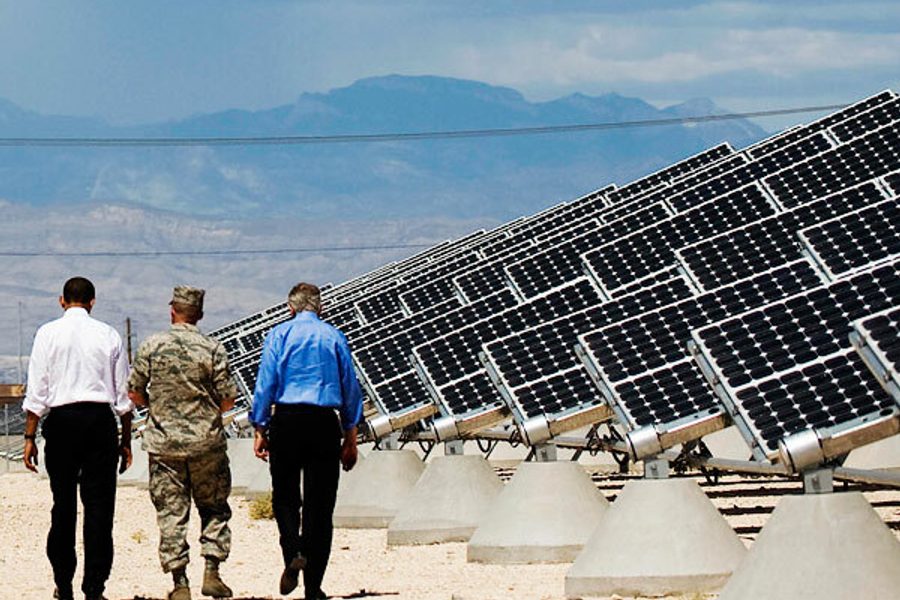When Renewable Is Not Sustainable
Ethanol and solar power deplete land and water resources.
Robert Glennon

Renewable energy is sold to the public as an environmentally benign alternative to energy produced by fossil fuels. With respect to ethanol and solar power, however, the debate has ignored how land and water use is affected by refining ethanol, growing corn and siting solar plants.
Energy production requires water. Producing petroleum, natural gas, coal or methane consumes a lot of water, but much less than it takes to make ethanol. In 2008, researchers at Virginia Tech quantified the amount of water it takes to produce one million British Thermal Units (BTUs): natural gas requires three gallons, ethanol as much as 29,100 gallons.
Even in a state-of-the-art refinery that recycles its water, four gallons of water are consumed for every gallon of ethanol produced. In 2007, Congress enacted the Energy Independence and Security Act, which mandates the production of 36 billion gallons of ethanol per year by 2022 – a 500-percent increase from current levels. The refining process alone will annually consume more than a two-month supply of water for the city of Chicago. That water is a drop in the bucket when we factor in the amount of water that is needed to grow the corn. To grow enough corn to refine a single gallon of ethanol can take as much as 2,500 gallons of water, and 2,500 multiplied by 36 billion is enough water to slake Chicago’s thirst for more than 100 years.
In Illinois, water used to grow corn comes mostly from rainfall, but further west, farmers mostly irrigate their fields. In Nebraska, for example, 75 percent of corn fields are irrigated. In the arid west, corn can’t be farmed without irrigation. And using water to irrigate crops always means that less will be available for other uses.
Consider the implications for California, which aspires to produce 1 billion gallons of ethanol annually. To grow the necessary corn would require using every drop of water currently diverted from the Sacramento-San Joaquin River Delta. That water irrigates 7 million acres in the Central Valley and provides critical supplies to Southern California’s cities – uses that can hardly be superseded by those of growing and refining corn for ethanol.
As the ethanol boom drove up the price of corn from $2 a bushel in 2006 to more than $4 in 2009, ethanol producers were delirious with joy. But food producers, such as hog and beef farmers, and beverage companies, such as Coca-Cola, complained that ethanol’s demand for corn was driving up food prices. Then the global economic meltdown caused the price of gas to plummet, making ethanol very expensive. Some proposed ethanol plants were shelved; some companies went bankrupt.
Yet, political support for ethanol remains strong. In May 2009, the Environmental Protection Agency (EPA) proposed rules to measure ethanol’s carbon footprint that would include the impact of farmers who cut down trees anywhere on earth to plant more corn. Members of Congress from farm states quickly introduced legislation to amend the Waxman-Markey Climate Bill to deny the EPA this authority. The House narrowly passed the bill in June 2009; at press time, it was still unclear whether the Senate would accept this provision.
Some biofuel visionaries believe that “cellulosic ethanol,” produced from the stalks and husks of corn – the waste product rather than the kernels – will be the future of the industry. But cellulosic ethanol remains a long way from being economically competitive.
Here comes the sun
The solar energy industry is similarly benefiting from federal legislation that paid no attention to water and land availability. In 2005, Congress enacted the Energy Policy Act, giving the Departments of Energy and Interior the mandate to establish renewable energy projects on federal land, which will generate more than 10,000 megawatts of electricity.
The obvious place to locate solar projects is in the desert Southwest, where the sun shines year-round. As of June 2009, solar power companies had filed applications for more than 150 permits for solar power plants on federal land in Arizona, California and Nevada, mostly land owned by the Bureau of Land Management (BLM), an agency of the Department of the Interior. Assembling a sufficient number of solar panels or mirrors for a power plant requires a large tract of land. The permits being evaluated by BLM involve more than one million acres of land, an area larger than the state of Rhode Island.
BLM has begun preparation of an Environmental Impact Statement (EIS). To date, the bureau hasn’t announced what kind of leases or permits it will grant corporations for the use of federal land. Clearly, there must be long-term arrangements if the plants are to be commercially viable. The net effect will be to turn over exclusive use of federal land to for-profit corporations.
More troublesome is the potential water use of these companies. If solar power is generated by photovoltaic cells, it uses almost no water. The cells directly convert the sun’s rays into electricity. Such systems are becoming more common in home applications, but still remain rare for commercial-scale power plants. They are extremely costly and the power is not constant, as it is generated only during the day when the sun shines. Utilities greatly prefer cheap 24/7 power.
For commercial power plants, solar companies use a technology known as “concentrating solar thermal” (CST). The sun heats a fluid that boils water. The steam spins a turbine that generates electricity. All thermal power plants produce waste heat as a byproduct and use cooling towers to release the waste heat to the ambient atmosphere – usually by the evaporation of water. Apart from the first step that uses the sun’s heat, CST is an old-fashioned thermal power plant that consumes vast quantities of water.
That’s not a problem for a plant located in Michigan, but 150 solar plants located in the Mojave Desert create a major water problem. Desert wildlife, including endangered species, depend heavily on rare seeps and springs that would likely dry up because of large-scale groundwater pumping.
It is feasible to air-cool CST plants but, again, the desert climate poses a problem. It’s hot outside, which makes dispersing the waste heat using hot desert air very inefficient. The solar companies prefer to use wet-cooled plants, because they cost almost 10 percent less to build and generate five percent more power than do air-cooled plants.
The National Park Service and many environmental organizations are beginning to realize that the water demands of ethanol and solar power are problematic. The Park Service has urged the Departments of Energy and the Interior to deny permits for water-cooled plants. Air cooling would reduce water consumption by as much as 90 percent. As the EIS process moves forward, these departments should give preference to plants that use air-cooling. The last thing we need are hundreds of commercial-scale groundwater wells drilled on water-scarce federal land.
Congress must integrate its energy and water policies. This is critical as global warming begins to reduce flows in western rivers, which translates directly into a loss of energy produced by hydroelectric facilities at federal dams. Replacing this lost energy without using fossil-fuel plants will be a real challenge.





